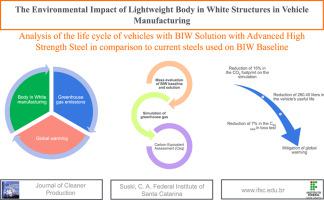当前位置:
X-MOL 学术
›
J. Clean. Prod.
›
论文详情
Our official English website, www.x-mol.net, welcomes your feedback! (Note: you will need to create a separate account there.)
The environmental impact of lightweight body in white structures in vehicle manufacturing
Journal of Cleaner Production ( IF 11.1 ) Pub Date : 2024-03-21 , DOI: 10.1016/j.jclepro.2024.141833 Cássio Aurélio Suski , José Francisco Silva Filho , Alexandre Cortez , Francisco Eduardo Gonçalves , Renan Rosa Ferreira
Journal of Cleaner Production ( IF 11.1 ) Pub Date : 2024-03-21 , DOI: 10.1016/j.jclepro.2024.141833 Cássio Aurélio Suski , José Francisco Silva Filho , Alexandre Cortez , Francisco Eduardo Gonçalves , Renan Rosa Ferreira

|
The quest for sustainability and reduction of human impact on the planet has led to discussions about environmental efficiency in the manufacture and use of automotive vehicles. The advancement of environmental and government laws has encouraged the automotive industry to seek constant improvements in safety, fuel economy and reduction of greenhouse gas emissions. To achieve these goals, reducing the weight of vehicles has been considered a relevant strategy, with several research and development efforts in search of high-tech materials and innovative design. The assessment of the life cycle of vehicles, from the extraction of raw materials to the end of their useful life, is essential for estimating environmental impacts. In this context, this paper focuses on the life cycle analysis of vehicles with new generation steel structures (Body in White Solution) compared to current steels (Body in White Baseline), aiming at reducing greenhouse gas emissions by reducing of the thickness of the steel plates, maintaining the mechanical properties necessary to guarantee the safety of the vehicle. The methodology of this study was divided into the evaluation of Body in White (BIW) mass in current steels (Baseline) and in advanced high resistance steels (Solution); detailing the vehicular life cycle from the extraction of materials to its end of life; in the estimation of greenhouse gas emissions through simulation and in the comparison of vehicle emissions with BIW in current steels and in advanced high resistance steels. As a result, it was possible to observe that, in the comparison of the CO footprint, modeled in the Eco Audit, there is a 15% reduction in emissions in the CO footprint for the BIW solution, as well as a 7% reduction in the C, in the on-site test and a saving of 260.40 L in fuel consumption, that is, the reduction in vehicle weight plays a significant role in reducing CO emissions, providing a mitigation factor for global warming.
中文翻译:

汽车制造中白色结构轻量化车身对环境的影响
对可持续性和减少人类对地球影响的追求引发了关于汽车制造和使用环境效率的讨论。环境和政府法律的进步鼓励汽车行业不断改进安全性、燃油经济性和减少温室气体排放。为了实现这些目标,减轻车辆重量已被视为一项相关策略,并在寻找高科技材料和创新设计方面进行了多项研发工作。评估车辆的生命周期(从原材料的提取到其使用寿命结束)对于估计环境影响至关重要。在此背景下,本文重点对新一代钢结构车辆(Body in White Solution)与现有钢材(Body in White Baseline)进行生命周期分析,旨在通过减少钢材厚度来减少温室气体排放板,保持保证车辆安全所需的机械性能。本研究的方法分为评估当前钢(基线)和先进高电阻钢(解决方案)的白车身(BIW)质量;详细描述车辆从材料提取到报废的生命周期;通过模拟估算温室气体排放量,以及将当前钢材和先进高电阻钢的车辆排放量与白车身进行比较。因此,可以观察到,在生态审计中建模的二氧化碳足迹比较中,白车身解决方案的二氧化碳足迹排放量减少了 15%,并且排放量减少了 7%。 C,在现场测试中节省油耗260.40L,即车辆重量的减轻对于减少CO排放起到了显着的作用,为全球变暖提供了缓解因素。
更新日期:2024-03-21
中文翻译:

汽车制造中白色结构轻量化车身对环境的影响
对可持续性和减少人类对地球影响的追求引发了关于汽车制造和使用环境效率的讨论。环境和政府法律的进步鼓励汽车行业不断改进安全性、燃油经济性和减少温室气体排放。为了实现这些目标,减轻车辆重量已被视为一项相关策略,并在寻找高科技材料和创新设计方面进行了多项研发工作。评估车辆的生命周期(从原材料的提取到其使用寿命结束)对于估计环境影响至关重要。在此背景下,本文重点对新一代钢结构车辆(Body in White Solution)与现有钢材(Body in White Baseline)进行生命周期分析,旨在通过减少钢材厚度来减少温室气体排放板,保持保证车辆安全所需的机械性能。本研究的方法分为评估当前钢(基线)和先进高电阻钢(解决方案)的白车身(BIW)质量;详细描述车辆从材料提取到报废的生命周期;通过模拟估算温室气体排放量,以及将当前钢材和先进高电阻钢的车辆排放量与白车身进行比较。因此,可以观察到,在生态审计中建模的二氧化碳足迹比较中,白车身解决方案的二氧化碳足迹排放量减少了 15%,并且排放量减少了 7%。 C,在现场测试中节省油耗260.40L,即车辆重量的减轻对于减少CO排放起到了显着的作用,为全球变暖提供了缓解因素。



























 京公网安备 11010802027423号
京公网安备 11010802027423号